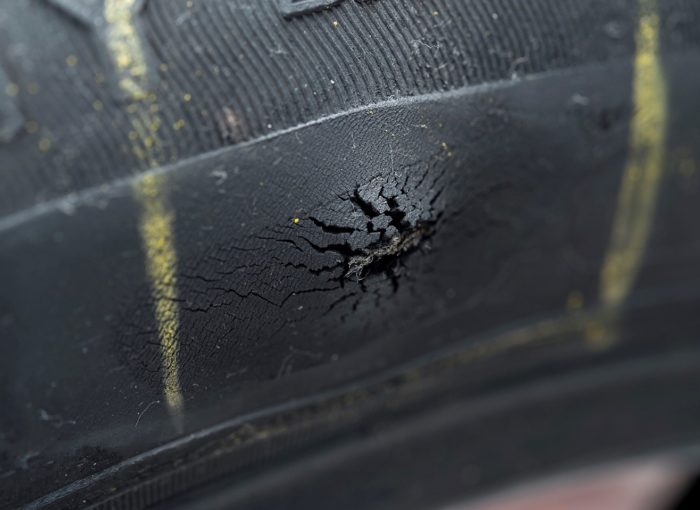Our reader was inspecting their tyres and they noticed a strange bulge in the tyre sidewall. They described it as looking like the bump that appears when someone is hit on the head in an old-school cartoon. These are known as a tyre bulge although they’re sometimes called bubbles or lumps. Whatever you call them, they’re not good news.
Dealing with tyre bulges
Why do tyres get bulges?
You have to understand how tyres are made to know why they get bulges. Obviously the compound including the rubber is one of the main components of a tyre. But to give the tyre its shape and strength, plies and wires made from metal or fabric are built into the rubber mix at the earliest stage of construction. These plies and cords hold the tyre wall firm and help to prevent damage caused by brushing kerbs, hitting potholes and so on.
While tyres are very strong, there are things that they can’t withstand. For example, hit a pothole at speed and the tyre can be forced against the wheel rim. This results in what experts call a rim pinch and causes cord damage.
When the cords snap, the rubber in the tyre sidewall is no longer strong enough to cope with the tyre’s internal air pressure. The air is strong enough to force its way out of the tyre’s liner but the external layer of rubber adjacent to the break holds it in, a bit like you can get bubbles under layers of cling film.
How long can you drive on a bulging tyre?
That depends on the kind of driving you do and how big the bulge is. You might be able to cover thousands of miles with a tyre bulge. But there is always a risk of tyre failure. And you need to be aware that this weakness is a bit like a leaking pipe or dripping tap: it’s never going to get better.
On top of that, continually driving on the tyre exacerbates the bulge. Tyre sidewalls are continually flexing while we drive. As the wheels rotate, it’s the side of the tyres as well as the car’s suspension that absorb potholes, road repairs and speed bumps. Throw in parking, where many of us continually brush our tyres against the kerb, and you’ve got a recipe for shortening the life of your slightly damaged tyre.

Are tyre bulges dangerous?
That depends how big the bulge is. But any weakness in a tyre is never a good thing. It’s only a matter of time before the visible bulge gets worse, the weak spot fails completely and the tyre blows out. And sudden tyre failures are never a good or safe thing.
Is a tyre bulge an MOT fail?
As we’ve seen, tyre bulges are potentially dangerous. The MOT is predominantly a road safety check and that’s why a tyre bulge will result in your car failing its MOT.
When you’re preparing your car for its MOT, it’s worth remembering that tyres can get bulges on their inner sidewalls as well as those on the more easily visible exterior surfaces.
Can a bulging tyre be fixed?
Just as a puncture in the sidewall of a tyre can’t be fixed, so neither can a bulge. A bulge is the result of damage to a structural part of the tyre and no repair would be strong enough to withstand the pressure a tyre sidewall undergoes during everyday driving.
How to take car of your tyres to prevent bulges
You can’t stop your tyres developing bulges. But you can ensure that the chance of developing a sidewall bubble is reduced. The main way to do this is by ensuring that the tyre pressure is set to the manufacturer’s recommended level. Under-inflated tyres are far more likely to suffer from bulges than ones that have been well maintained.
You can also do your best to avoid hitting kerbs or potholes. Of course, the latter is easier said than done but you can reduce the potential for damage. If you see a pothole and can’t avoid it, try to hit it head on so that the force of the impact is spread across both sides of the tyre. There’s no guarantee you’ll escape damage but there’s a chance you’ll reduce serious harm.
How to spot tyre bulges
You have to know what you’re hunting for. Imagine an air bubble in the sidewall of the tyre and that’s pretty much what you’re looking for. Some are easy to spot in daylight. But it’s best to use a torch: the strong directional light will help to create contrast that will make lumps in the tyre show up.
What happens if your tyre blows out?
If your tyre deflates suddenly, known as a blow out, the temptation is to come to a halt as quickly as you can. But jump on the brakes and you’re likely to have a massive accident. Instead, ease of the accelerator gently and let the car scrub off momentum of its own accord while you do your best to keep it going in a straight line.

I’ve been writing about cars and motoring for more than 25 years. My career started on a long-departed classic car weekly magazine called AutoClassic. I’ve since pitched up at Autosport, Auto Express, the News of the World, Sunday Times and most recently the Daily Telegraph. When I’m not writing about cars and motoring, I’m probably doing some kind of sport or working in my garden.







